In today’s digital age, understanding how content marketing drives sales is crucial for businesses aiming to thrive in a competitive marketplace. At its core, content marketing isn’t just about producing and sharing content; it’s about creating connections and building relationships with your audience. This approach helps to educate, engage, and influence potential customers, guiding them through their buyer’s journey from awareness to decision-making. With a strategic approach, content marketing can significantly boost sales by attracting the right audience and providing them with the value they seek. Let’s delve into the essence of content marketing and uncover its power in driving sales, ensuring that every piece of content you create serves a purpose in your broader sales strategy.
The Role of Content Marketing in Driving Sales
Content marketing is key to boosting sales. It engages potential buyers at every step of their journey. Instead of just advertising products or services, it offers valuable information. This method builds trust and credibility, essential for turning leads into loyal customers.

Building Awareness
Businesses draw attention by sharing informative content. They position themselves as experts in their field. This is vital for attracting people who might not know your brand or solutions yet.
Educating Prospects
Content like guides, blog posts, and videos teach your audience about their problems and solutions. This valuable knowledge helps consumers make informed choices, pushing them towards a purchase.
Nurturing Relationships
Regular and personalized content keeps your brand in the minds of your audience. This ongoing engagement is crucial for guiding leads closer to a sale, making them feel supported.
Closing Sales
Content marketing tackles common doubts and questions, helping convince prospects to buy. Stories of success, case studies, and testimonials are effective here, showing how your products or services work in real life.
Encouraging Repeat Business
Content marketing doesn’t stop after a sale. It helps maintain customer loyalty and encourages them to buy again. Engaging content keeps your brand relevant, turning happy customers into advocates.
Aligning content marketing with the sales funnel creates a smooth journey for customers. This strategy not only boosts sales but also lays the groundwork for lasting customer relationships.
Understanding the Sales Funnel
The sales funnel illustrates the path potential customers take before buying. It’s essential for developing a content marketing strategy that boosts sales. This funnel includes several phases: Awareness, Interest, Decision, and Action. We’ll explore these stages and the role of content marketing in each.
Awareness Stage: Here, potential customers discover your brand. Content marketing aims to catch their eye and create a memorable first impression. Blogs, social media, and informative articles work well to increase awareness and attract people to your funnel.
Interest Stage: After grabbing their attention, it’s crucial to keep them engaged. Content at this phase should deepen their interest with more detailed information. E-books, newsletters, and webinars are great for educating your audience about your solutions.
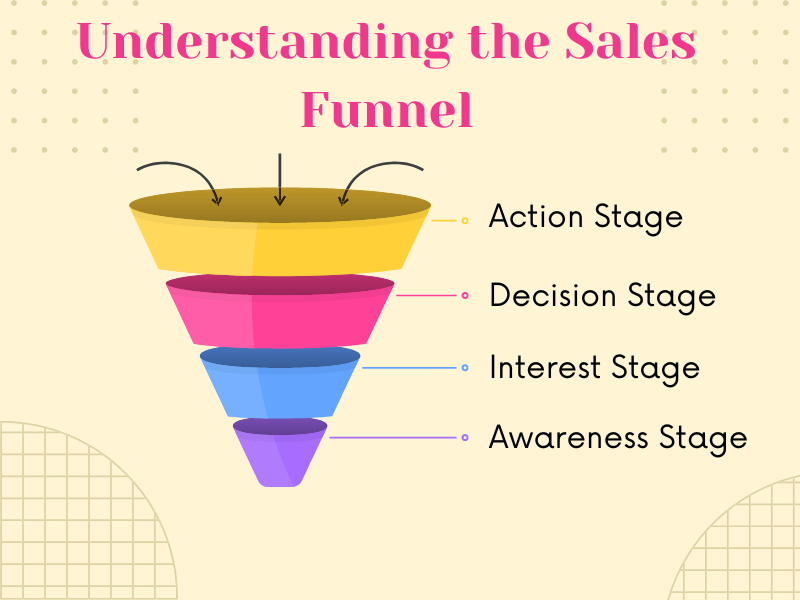
Decision Stage: Now, potential customers weigh their options. They compare what you offer against competitors. Content like product comparisons, customer testimonials, and case studies can be very convincing. They help clear doubts and show why your brand stands out.
Action Stage: This is where purchases occur. Content marketing can give a final push here too. Offers, free trials, and demos can motivate prospects to buy.
Creating Compelling Content that Converts: The Key to Successful Sales
Knowing your sales funnel and understanding your audience’s needs at each step lets you craft targeted content. This approach addresses their queries and concerns, building trust and guiding them through their journey, ultimately increasing sales.
Creating content that drives sales is vital. This content should connect with your audience, solve their problems, and encourage them to buy. Here’s how to make your content work:
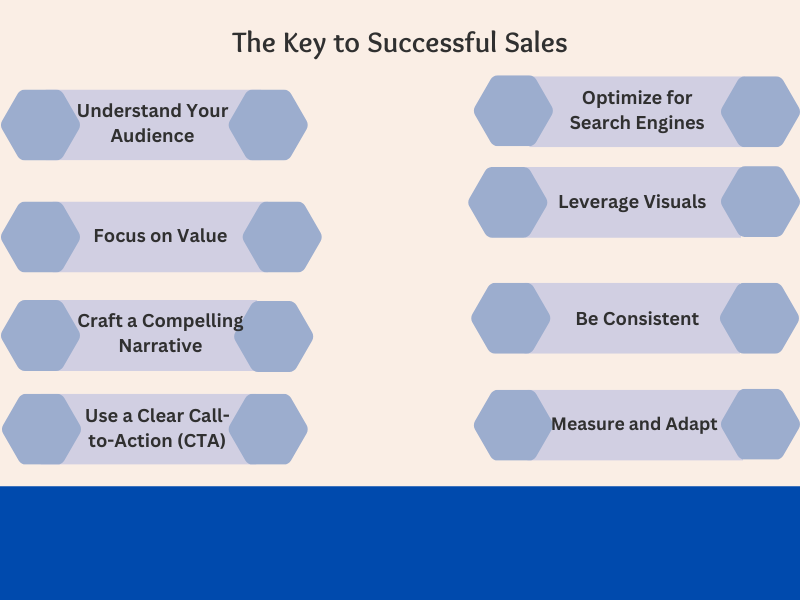
Understand Your Audience: Know who your audience is and what they want. Use market research and feedback to learn about their needs.
Focus on Value: Your content must help your audience in some way. It should solve a problem, share insights, or entertain.
Craft a Compelling Narrative: People love stories. Use them to show how your products or services can improve lives.
Use a Clear Call-to-Action (CTA): Guide your audience on what to do next. A clear CTA moves readers closer to becoming customers.
Optimize for Search Engines: Make your content easy to find online. Use keywords and write clear meta descriptions to attract more visitors.
Leverage Visuals: Use images, infographics, and videos to make your content more engaging. Visuals can explain complex ideas simply and keep people interested.
Be Consistent: Regular, quality content builds trust. Plan your posts to keep your audience coming back for more.
Measure and Adapt: Keep track of how your content performs. Use this data to improve and focus on what works best.
By focusing on these tips, you can create content that not only grabs attention but also convinces your audience to take action. The aim is to build lasting relationships and trust, leading to more sales and loyalty.
Identifying Your Target Audience and Understanding Their Needs
Creating a content marketing strategy that hits the mark starts with a clear picture of who you’re talking to. It’s about getting to know your audience so well that your content feels like it’s speaking directly to them, answering their questions, and solving their problems. Here’s how to get there:
Get to Know Your Audience: Kick things off by diving into the data. Look at who’s already interacting with your brand and why. This means sifting through feedback, analyzing who’s active on your social media, and looking at market trends. It’s detective work aimed at understanding your crowd.
Craft Buyer Personas: Think of creating buyer personas as sketching out the portraits of your dream customers. These aren’t random sketches but are based on real insights and educated guesses about their lives, struggles, and what they’re after. These personas are your guides, helping you tailor your messages just right.
Zoom in on Their Challenges: Understanding what keeps your audience up at night is key. Your content should feel like a helping hand, offering solutions and comfort, showing you get what they’re going through.
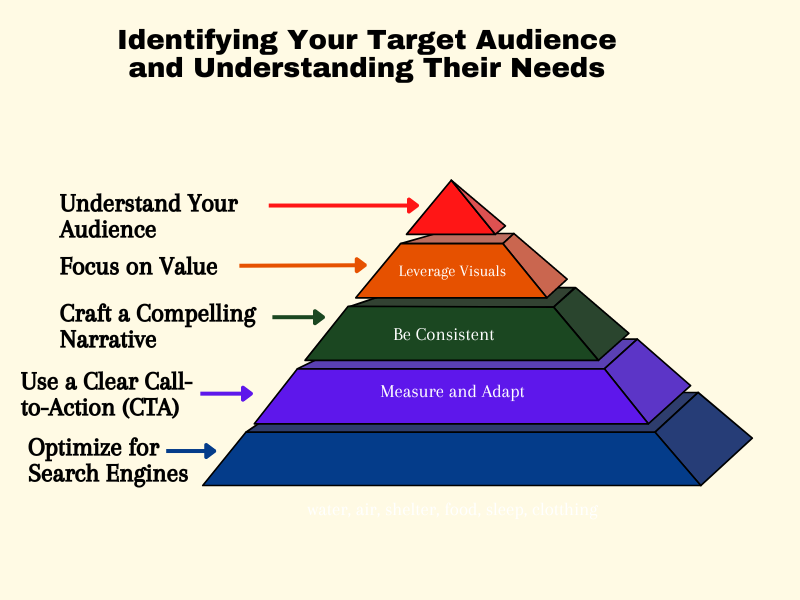
Figure Out What Drives Them: It’s all about knowing what makes your audience tick. Are they looking to save time, cut costs, or just make their lives easier? When you know this, you can shape your content to hit those buttons.
Listen to Social Chatter: Social media and forums are like treasure troves of insights. Pay attention to the buzz—what are people asking about, and what’s getting them excited? This is gold for shaping a content strategy that resonates.
Keep an Eye on the Competition: Watching what works for your competitors can teach you a lot. It’s not about copying but understanding what engages their audience and finding your unique angle to connect with yours.
Tailor Your Approach: Remember, your audience isn’t a monolith. They’re a mix of different people with varying interests and needs. Segmenting them lets you personalize your content, making every piece more impactful.
Open Up Feedback Channels: Make it easy for your audience to talk back. Whether it’s comments, direct messages, or social media interactions, these feedback loops are invaluable for staying in sync with their evolving needs.
Mastering your understanding of your target audience is an ongoing journey, not a one-time task. It’s about keeping your ear to the ground and adapting as their needs and the landscape change. By doing so, you ensure your content not only captures attention but also fosters connections that drive sales.
Crafting an Effective Content Strategy to Drive Sales
An effective content strategy acts as the foundation for successful marketing efforts. It aligns each content piece with your business goals. It also ensures you meet your audience’s needs. Here’s a guide to create a strategy that converts prospects into customers and enhances your sales:

Set Clear Objectives: Start by identifying your content marketing goals. This could be boosting brand awareness, generating leads, or increasing sales. Clear objectives guide your content creation and help track success.
Understand Your Audience’s Journey: Map the customer’s journey from initial awareness to the final purchase. Knowing this journey helps you tailor content for your audience’s needs at each funnel stage.
Choose the Right Content Types: Select content forms that resonate with your audience. Consider their journey stages and preferences. Options include blog posts, social media updates, eBooks, webinars, and videos.
Create a Content Calendar: A content calendar ensures consistent content flow. It also helps time content releases with important dates or buyer journey stages.
Focus on Quality Over Quantity: Quality content engages and converts your audience better than a large quantity of low-value content.
Optimize for SEO: Enhance your content for search engines to boost visibility. Include relevant keywords, meta descriptions, and optimize media to improve SEO rankings.
Promote Your Content: Great content needs promotion. Use email, social media, paid ads, and more to broaden your content’s reach.
Measure and Analyze Performance: Track your content’s success using analytics. Assess traffic, engagement, conversions, and ROI to understand what works and what doesn’t. Use this data to refine your strategy.
Iterate and Optimize: Content marketing requires ongoing adjustment. Use insights from analytics to tweak your strategy, try new ideas, and continually increase your content’s impact.
Encourage Engagement: Build a community by promoting interaction with your content. Comments, shares, and discussions can deepen audience connections and encourage progression through the sales funnel.
By adopting these strategies, you can craft a content plan that not only attracts visitors but also fosters relationships and boosts sales. Effective content strategies are adaptable, evolving with feedback and market shifts.
Creating High-Quality and Engaging Content that Resonates with Your Audience's Pain Points and Desires
To drive sales with content marketing, focus on creating content that directly addresses your audience’s needs, challenges, and wishes. Here’s a guide to crafting content that connects and prompts action:
Address Pain Points: Begin by deeply understanding your audience’s struggles. Craft content that offers solutions, advice, and relief. Show empathy and insight to become a trusted advisor.
Highlight Benefits, Not Just Features: Focus on how your products or services benefit customers. Illustrate how they can improve lives, solve problems, or help achieve goals.
Use Relatable Language: Speak in terms your audience easily grasps. Steer clear of jargon, unless it’s familiar to your target group. Aim for accessibility and relatability in your content.
Incorporate Storytelling: Stories captivate naturally. Weave storytelling into your content to emotionally engage your audience. Share success stories, your brand’s history, or how your products come to life.

Leverage Visual Content: Enhance your content with images, infographics, and videos. Visuals can clarify complex ideas and hold your audience’s attention longer.
Provide Actionable Insights: Share practical advice and tips. Content that enables your audience to act is invaluable and more likely to spur engagement and conversions.
Encourage Interaction: Invite your audience to engage with your brand. This can be through comments, shares, or surveys. Interaction fosters community and brand loyalty.
Optimize for Readability: Make your content easy to read and navigate. Use headings, bullet points, and short paragraphs. This enhances user experience and SEO.
Update and Refresh Content: Regularly review and update your content to stay current. Keeping content relevant ensures it continues to add value.
Experiment with Formats: Test various content formats to find what your audience prefers. Trying out blogs, videos, podcasts, and more can expand your reach and satisfy different tastes.
Distributing and Promoting Your Content: Reaching the Right People at the Right Time
Once you’ve crafted your content with care and creativity, the journey to making a real impact begins. It’s all about getting your message in front of the people who need to see it. Let’s walk through the steps to ensure your content not only reaches its audience but resonates with them too.
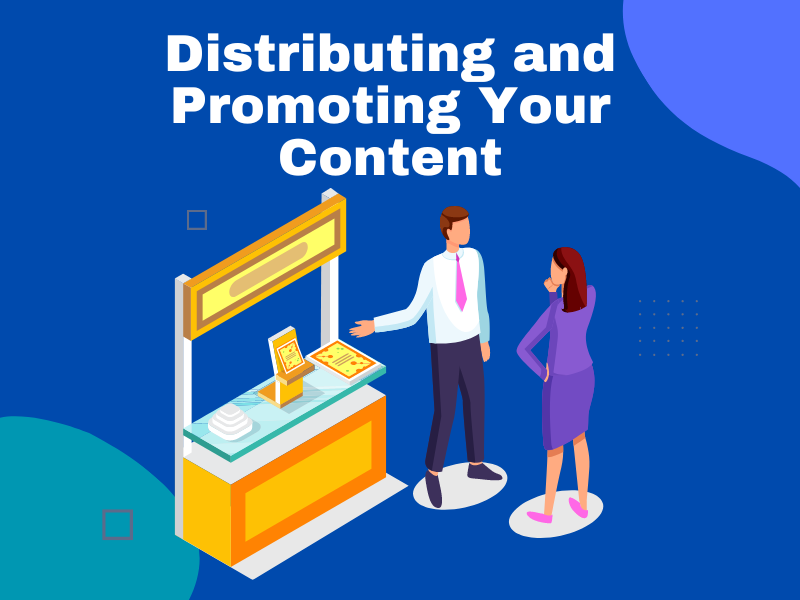
Social Media Wisdom: Think of social media as your content’s best friend. It’s where you can share, connect, and engage. Remember, not all platforms are created equal. LinkedIn shines for professional content, while Instagram is your go-to for eye-catching visuals. Tailor your content to fit each platform’s vibe.
Email Marketing Magic: Don’t underestimate the power of a well-crafted email. It’s your direct line to your audience. Make it personal, make it relevant, and watch engagement grow. Segmenting your list helps tailor your message, ensuring it lands with the right group.
Paid Promotion Power: Sometimes, a little investment goes a long way. Paid ads on platforms like Facebook, Google, and LinkedIn can dramatically expand your content’s reach. Use targeted options to zero in on your ideal audience.
Influencer Partnerships: Aligning with the right influencers can catapult your content into new territories. Look for voices in your industry whose followers align with your target audience for maximum impact.
SEO Strategies: Make your content a magnet for search engines. Keywords, meta descriptions, and image alt texts are your tools to improve visibility and climb the search results ladder.
Guest Posting: Stepping out onto other reputable sites can introduce your brand to wider circles. Choose your spots wisely, aiming for places where your audience hangs out.
Content Syndication: Sharing your content on third-party sites can spread your message far and wide. Just make sure these platforms are a good fit for your industry and message.
Community Engagement: Dive into forums and communities where your industry’s conversations are happening. Add value, share insights, and sprinkle in your content where it naturally fits. Platforms like Reddit and Quora are perfect stages for this.
Internal Advocacy: Encourage your team to become content champions within their networks. Their shares can amplify your reach and add a layer of trust.
Strategy Analytics: Keep a close eye on how your content performs. Use analytics to guide your strategy, focusing on metrics like reach, engagement, and conversions. It’s all about learning, tweaking, and improving.
Analyzing and Optimizing Your Content Marketing Efforts for Maximum Sales Impact
To boost your sales through content marketing, you must analyze and tweak your strategy regularly. This involves pinpointing which content clicks with your audience, the best channels for distribution, and how it all ties back to your sales objectives. Let’s dive into how you can effectively carry out this process:
- Set Key Performance Indicators (KPIs): Determine the key metrics that align with your sales goals. This can range from website visits and lead generation rates to engagement levels (likes, shares, comments) and sales revenue linked to your content marketing.
- Use Analytics Tools: Implement tools such as Google Analytics, social media analytics, and email marketing reports. These will help you track your content’s impact and identify the most effective pieces in driving conversions.
- Evaluate Content Performance: Consistently assess how your content is performing. Find out which formats (blog posts, videos, infographics) and topics truly engage your audience and aid your sales funnel.
- Analyze Traffic Sources: Know where your audience comes from. This insight allows you to tailor your promotion strategies more effectively. For example, a surge in organic search traffic might signal a need to double down on SEO efforts.
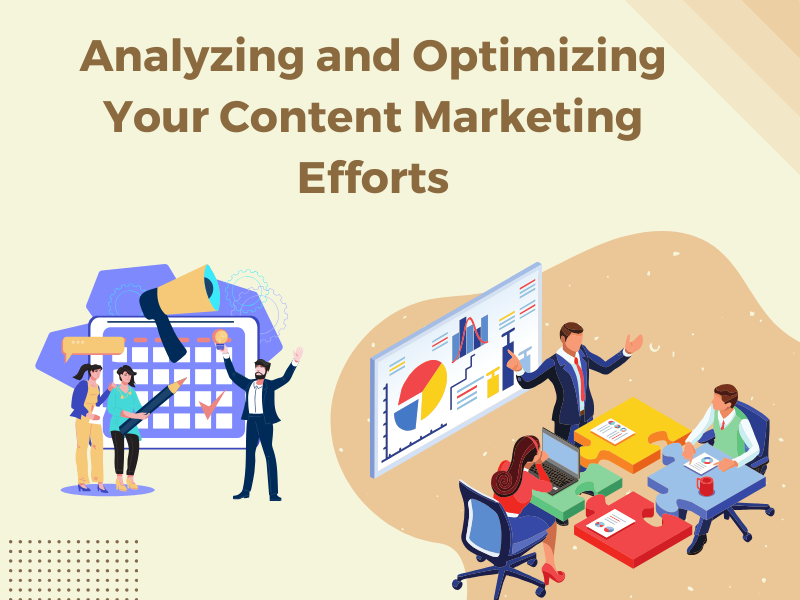
- Track Conversion Paths: Monitor how customers progress through your sales funnel. Identifying the most persuasive content pieces can illuminate the path from reader to lead to customer.
- Gather Audience Feedback: Direct feedback offers invaluable insights into potential content improvements. Utilize surveys, social media, and comments for this purpose.
- Test and Experiment: Experiment with varying content formats, headlines, calls to action, and distribution channels. A/B testing can pinpoint what best resonates with your audience and boosts conversion rates.
- Optimize for SEO: Keep your content search engine friendly by regularly updating old posts, enhancing on-page SEO, and aligning content with what your audience is searching for. This attracts more qualified leads.
- Refine Your Content Strategy: Use your findings to fine-tune your strategy. This could mean shifting to more impactful content types, tweaking your publication schedule, or targeting new audience segments.
- Monitor Industry Trends: Keeping a pulse on both industry and content marketing trends ensures your strategy stays relevant. Adapting to new technologies, platforms, and consumer preferences can keep your content engaging.
Utilizing Search Engine Optimization (SEO) to Drive Sales
Search Engine Optimization (SEO) plays a key role in content marketing, especially when the goal is to increase sales. It makes your content more visible and highly ranked in search engine results. This leads to more potential customers finding your products or services. Here’s how to use SEO effectively to boost your sales:
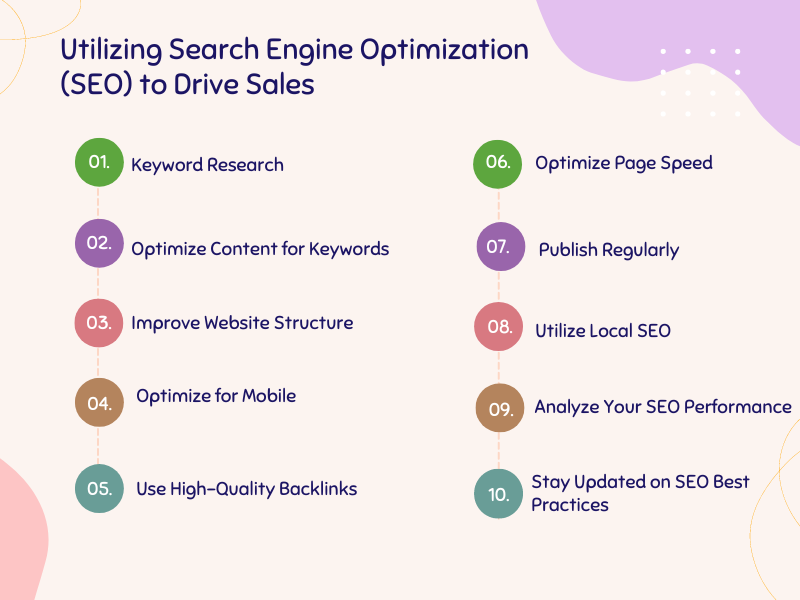
Keyword Research: Begin with finding the keywords your audience uses to search for your offerings. Tools like Google Keyword Planner, SEMrush, or Ahrefs are perfect for this. They help you create content that meets your audience’s needs.
Optimize Content for Keywords: Use your keywords wisely. Include them in titles, headings, text, meta descriptions, and URLs. But, remember, overusing them can harm your SEO.
Improve Website Structure: A structured website offers a better user experience. It also makes it easier for search engines to navigate your site. Ensure clear navigation and link your content internally.
Optimize for Mobile: As mobile searches grow, a mobile-friendly site is crucial. Google now prioritizes your site’s mobile version. Make sure your site is responsive and works well on various devices.
Use High-Quality Backlinks: Links from trusted sites boost your SEO. Create content that others want to link to. Guest blogging is a good way to build your backlink profile.
Optimize Page Speed: A fast-loading site ranks better and keeps visitors engaged. Use Google Page Speed Insights to check and improve your site’s speed.
Publish Regularly: Keep your content fresh and relevant. A content calendar helps plan and maintain a steady flow of new content. This attracts more visitors and shows search engines your site is active.
Utilize Local SEO: If you serve a specific area, local SEO is vital. Make sure your business is on online directories and Google My Business. Use location-based keywords to draw in local customers.
Analyze Your SEO Performance: Track your content’s success with SEO analytics tools. Look at organic traffic, bounce rate, and conversion rate to fine-tune your strategy.
Stay Updated on SEO Best Practices: SEO changes frequently. Keep up with the latest trends and updates to keep your strategy effective.
Content Creation for Increasing Sales Revenue
Content creation is a potent tool to boost sales revenue. It draws, engages, and persuades your target audience. Through valuable and relevant content, you lead potential customers from initial awareness to making a purchase. Here are effective strategies for content that elevates sales revenue:
Identify Content That Aligns with Sales Goals:
Start by pinpointing content types that significantly impact sales goals. Analyze previous performances to spot trends and preferences in your target audience. Focus on tutorials, product reviews, comparison guides, and case studies. These formats highlight your offerings’ value.
Educate Your Audience:
Produce content that informs your audience about your products or services and their problem-solving capabilities. This includes how-to guides, webinars, and FAQ sections. Informing your audience builds trust and credibility, making them more likely to choose your brand.

Use Persuasive Copywriting:
The words you select can dramatically affect sales revenue. Employ persuasive copywriting to craft compelling product descriptions, landing pages, and calls-to-action (CTAs). These elements should motivate readers to take action.
Showcase Customer Testimonials and Success Stories:
Real-life examples of your products or services making a difference can persuade effectively. Incorporate customer testimonials, case studies, and before-and-after stories in your content. This builds trust and encourages purchases.
Create a Sense of Urgency:
Highlight limited-time offers, exclusive deals, and countdown timers to create urgency. This approach encourages immediate action. Use content to spotlight these offers, driving sales during promotional periods.
Optimize for Conversion:
Make sure your content is conversion-optimized. Include clear, compelling CTAs. Your CTAs should be visible and actionable, whether for signing up for a newsletter, downloading a guide, or making a purchase.
Leverage Video Content:
Videos are highly effective in showcasing your products or services. Include product demos, tutorials, and behind-the-scenes looks. Videos engage your audience and help them visualize using your offerings.
Personalize Your Content:
Customize your content for different audience segments. Personalized content is more relevant and engaging, leading to higher conversion rates.
Measure and Refine:
Constantly measure your content’s impact on sales revenue. Use analytics to track engagement, conversions, and ROI. Refine your content strategy based on these insights, focusing on what resonates with your audience and business goals.
Integrate with Other Marketing Efforts:
Coordinate your content marketing with other strategies, like email marketing, social media, and paid advertising. A unified approach amplifies your message and drives better results.
Leveraging Social Media Platforms for Content Marketing
Navigating the world of social media can dramatically enhance your brand’s presence, allowing you to connect with your audience in a dynamic way. Here’s a streamlined approach to make the most of social media for content marketing:

Choose the Right Platforms: It’s essential to be where your audience is. For professional services, LinkedIn could be your go-to, whereas Instagram or Pinterest might be more suitable for visually-oriented businesses.
Craft Content with Each Platform in Mind: Each social media channel has its own vibe and requirements. Adjust your content to fit — whether it’s short and sweet for Twitter or more detailed for LinkedIn. Make use of specific features like Instagram Stories to keep things interesting.
Interact with Your Audience: The beauty of social media lies in its two-way street nature. Engage by responding to comments and messages. This not only builds a community but also deepens loyalty and could even spark organic promotion through word-of-mouth.
Strategic Use of Hashtags: Expand your content’s reach with thoughtful hashtags. While they should be relevant and platform-appropriate, be careful not to overstuff your posts with them.
Embrace User-Generated Content: Encourage your followers to share their own stories related to your brand. Reposting their content not only adds variety to your feed but also enhances credibility and trust with potential customers.
Plan with a Content Calendar: Keep your posting schedule consistent and varied with a content calendar. This foresight keeps your audience engaged and looking forward to what’s next.
Explore Social Media Advertising: To widen your reach, invest in social media ads. Tailored ads on platforms like Facebook, Instagram, and LinkedIn can introduce your brand to a broader yet targeted audience.
Monitor and Adapt Based on Analytics: Utilize analytics to gauge the success of your posts. Understanding what resonates with your audience allows you to refine your strategy and content for better results.
Partner with Influencers: Collaborate with influencers who align with your brand values. Their endorsement can lend authenticity and extend your reach within their follower base.
Keep Up with the Latest Trends: Social media evolves at lightning speed. Stay informed on trends and platform updates to ensure your content remains relevant and engaging.
Conclusion
Unlock sales growth with smart content marketing! In the fast-paced digital arena, mastering content creation and distribution is key. Connect, engage, and convert your audience by aligning content with their journey, addressing their needs, and boosting visibility through SEO. Leverage social media for insights and adapt your strategy to stay ahead. At its core, content marketing is about delivering value, solving problems, and inspiring action. Embrace creativity, analytics, and strategic planning to foster meaningful relationships and drive sustainable business growth. Start transforming your approach today for impactful results tomorrow. Dive into the content marketing journey—where every step counts towards achieving your sales targets.







Thanks for sharing. I read many of your blog posts, cool, your blog is very good.
Thank you so much for your kind words! I’m glad to hear that you’ve been enjoying my blog posts. Your support and feedback mean a lot to me. Stay tuned for more content!